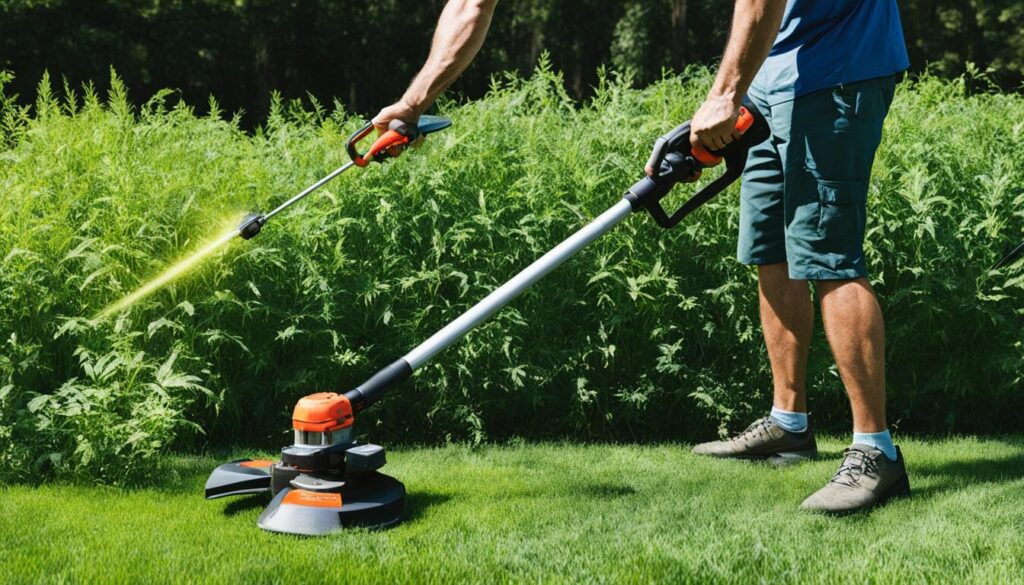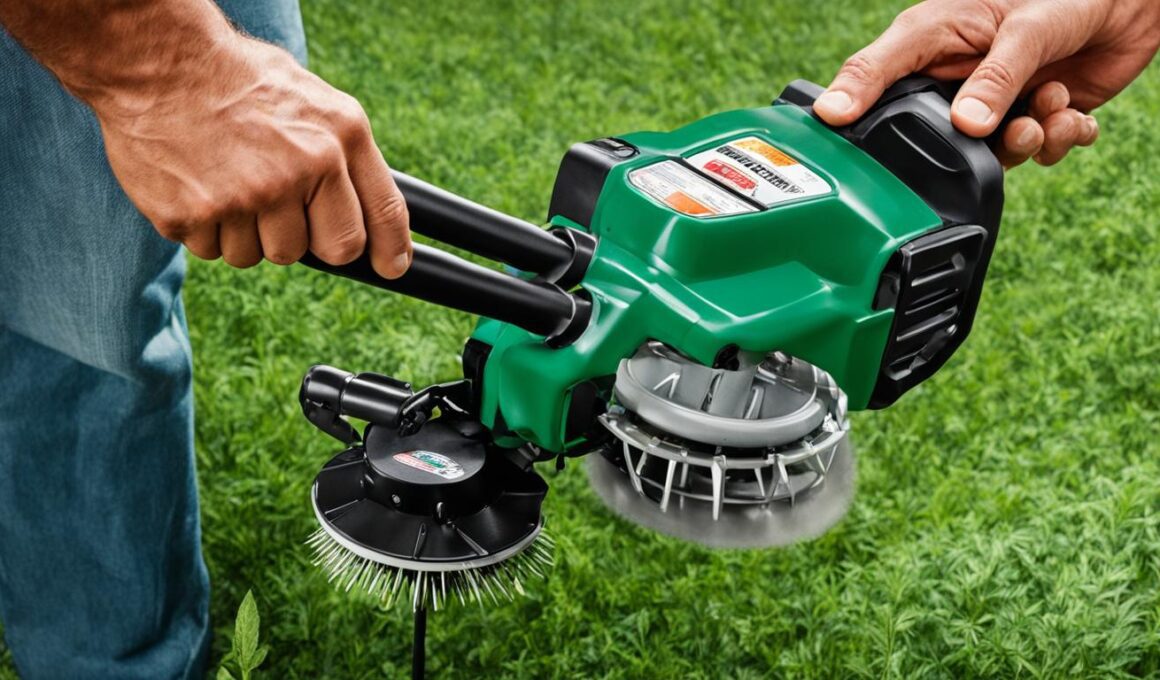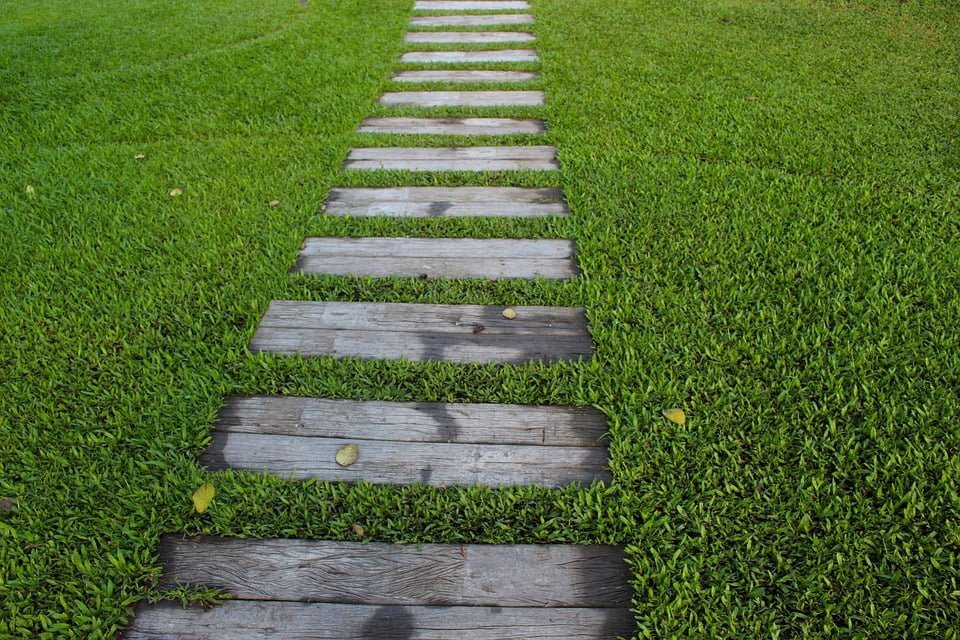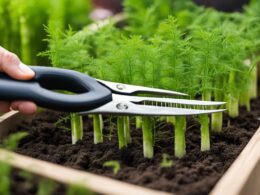Welcome to our comprehensive guide on how to effectively use a weed eater, a must-have landscaping equipment for maintaining a well-groomed yard. Whether you refer to it as a weed eater, trimmer type, or weed whacker, this versatile tool is essential for keeping your lawn looking manicured. In this article, we will provide you with essential tips to maximize safety and effectiveness when using a weed eater.
Choosing the Right Weed Eater for Your Needs
When it comes to selecting a weed eater, you want to make sure you choose the right one for your specific needs. With various types of landscaping equipment available, including plug-in weed whackers, battery-powered weed whackers, and gas-powered weed whackers, it’s important to consider factors such as power, convenience, and the size of your yard.
If you’re looking for a powerful and quiet option, plug-in weed whackers are a great choice. They provide consistent power and are ideal for medium to large yards. However, keep in mind that they require the use of an extension cord, which may limit your mobility.
Battery-powered weed whackers, on the other hand, offer more flexibility. They are cordless, making them perfect for smaller yards or areas with limited power outlets. These models are lightweight and easy to maneuver. However, they may struggle with thick grass and require recharging or battery replacements for extended use.
For those who need maximum power and stamina, gas-powered weed whackers are the go-to option. Preferred by commercial maintenance crews, these weed eaters boast extended use time and are capable of tackling larger areas with thick vegetation. However, they may be heavier, noisier, and produce emissions.
No matter which type of weed eater you choose, it is important to read and follow the manufacturer’s instructions for proper usage and maintenance. Additionally, dress appropriately with long-sleeved shirts, long pants, closed-toe shoes, gloves, and safety glasses to protect yourself from any potential hazards.
With the right weed eater in hand, you’ll be equipped to tackle the toughest landscaping tasks with ease and efficiency.
Techniques for Using a Weed Eater
When it comes to using a weed eater, there are a variety of techniques you can employ to achieve a well-groomed yard. Whether you’re edging, tapering, trimming, or scything, each method requires proper execution and attention to detail.
Edging
When edging with a weed eater, it’s important to hold the string trimmer parallel to the ground and walk in a straight line along the edge of your driveway, walkway, or any other defined area. This technique creates clean, crisp lines that separate your lawn from the hard surfaces.
Tapering
If you have curbs, fences, or trees in your yard, tapering is the technique you’ll want to use. Hold the string trimmer at an angle and smoothly trim along the edges of these structures. Tapering adds a polished, manicured look to your landscape.
Trimming
For general trimming of grass and weeds, hold the weed eater at a slight angle and move it from side to side. This motion allows the string trimmer to cut through unwanted vegetation efficiently. By maintaining a consistent height and angle, you’ll achieve an even and well-maintained trim.
Scything
Scything is a technique best suited for cutting down tall grass and dense vegetation. Hold the weed eater parallel to the ground, and using a smooth and sweeping motion, mow down the overgrown areas. This technique is particularly effective for tackling larger sections of your lawn.
Screeding
When it comes to removing weeds from cracks in your driveway or sidewalk, screeding is the way to go. Hold the string trimmer at a shallow angle and run it along the cracks, effectively removing any unwanted growth.
Remember, regardless of the technique you’re using, maintaining a consistent height and angle with your weed eater is crucial in achieving a professional-looking result. Practice these techniques and take your yard maintenance to the next level!

Conclusion
Using a weed eater is a versatile and effective way to maintain a manicured lawn. By following these essential tips, you can ensure safety and achieve excellent results. Firstly, always wear the necessary safety gear, including safety glasses, gloves, and sturdy shoes. Secondly, choose the right weed eater for your specific needs, whether it be a plug-in, battery-powered, or gas-powered model. Each type has its advantages and limitations, so consider your yard size and grass thickness when making a selection.
Additionally, mastering the proper techniques for using a weed eater is crucial. Whether you are edging, tapering, trimming, scything, or screeding, maintaining a consistent height and angle is key to achieving an even and professional-looking trim. Familiarize yourself with the manufacturer’s instructions, as they provide important guidance for using your specific weed eater.
Finally, remember to properly maintain your weed eater and replace the string when necessary. Regularly inspect and clean your equipment, as well as store it in a safe and secure location. By following these guidelines and taking care of your landscaping equipment, you can use a weed eater effectively and safely to keep your yard looking neat and well-maintained.
Can the Same Tools and Techniques Used to Sharpen Loppers Be Applied to Sharpening a Weed Eater?
Yes, the same tools and techniques used to sharpen loppers can be applied to sharpening a weed eater. By using a flat file and a vice to hold the tool securely, you can sharpen loppers effectively and also use the same process for sharpening a weed eater blade.









